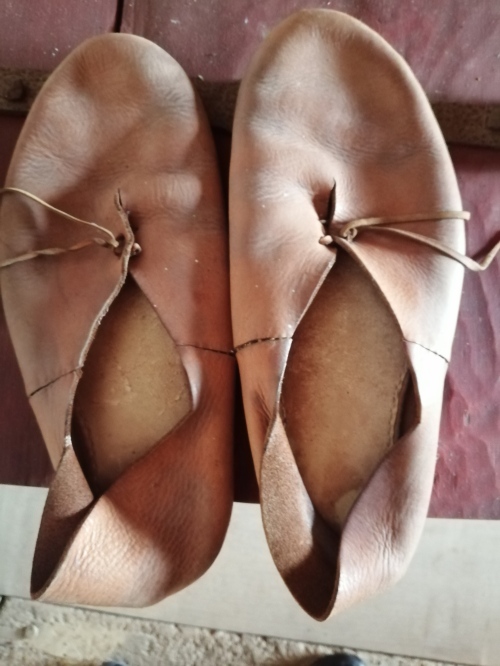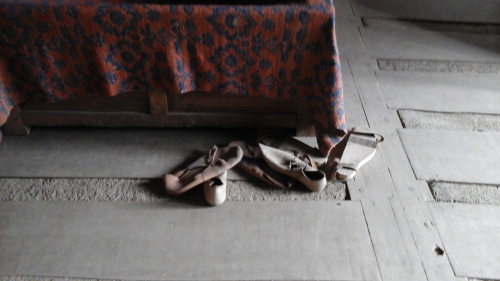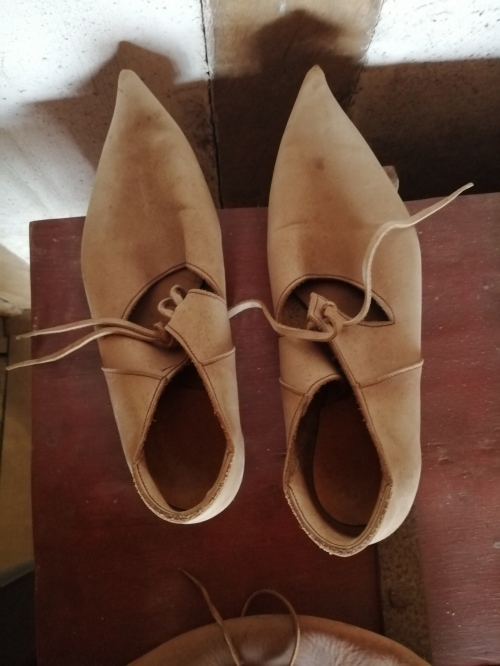
In the fourteenth century shoes were mostly made from leather, which was often tawed, rather than tanned. Tanning changed the structure of the leather, making it last longer and less likely to decompose. Tawing, on the other hand, was a process that made the leather softer and easier to stretch. The leather was soaked in a solution that could include egg yolks, flour and potash.
Leather shoes were made by the turnshoe method. A soft piece of leather – the upper – was placed skin side down on the last. It was stitched to the sole and turned inside out.
Most shoes were very simple and men’s and women’s shoes were similar. At the beginning of the fourteenth century there wasn’t even any difference between right and left shoes, other than that made by the wearer’s feet in use. Over the course of the century this changed, at least in the shoes made for the wealthy.
There were various ways of making sure that shoes didn’t come off. They could be laced on the side or top, buckled, and they might be made with or without back straps.
Shoes for the wealthy could have patterns scored in them in which the top of the leather was scraped away to reveal the suede beneath. Alternatively, leather uppers could be decorated with scoring, patterning of the leather and embroidery.
Sometimes the leather was decorated by punching holes in it to make diamond-shaped openings, forming a lattice on the upper of the shoe. Sometimes the spaces created would be filled with embroidery. It made the leather very fragile, though, so was presumably something only for the wealthy, for whom shoes tended to be more decorative than useful or hard-wearing

It was also during the fourteenth century that fashionable clothing became important. This didn’t just mean making clothes and shoes from better quality materials, but wearing styles that made it obvious that the wearer didn’t do physical labour or even walk very far. The most notorious example of this was the long-toed poulaine shoe, in which the thin, pointed toe could be as long again as the foot. No one who wore it could be in a hurry to get anywhere, nor could they walk very far. These shoes were popular at the court of Richard II. They were completely impractical for anything other than standing around looking important and were really just for aristocrats. They were condemned by the church in the mid-fourteenth century as being ‘more like the talons of a demon than the ornaments of men’. Contrary to popular belief, the points of the toes were not tied to the wearer’s legs. They were never that long. The photograph below shows an interpretation of the style for people who liked to look fashionable, but still had to work.

Sometimes the toes of poulaines were stuffed with hair or moss. In case you’re interested, researchers know what kind of moss was most used in London. It was thuisium tamarascinuum, which was both springy and absorbent.
There were other kinds of shoes available in the fourteenth century: buskings, ankle shoes, bateaux, galoches and trippes. In a different kind of fashion statement, some men had leather soles sewn into the bottom of their hose, so that it looked as if their shoes were the same colour as their leggings.
Most villages had someone who could work leather. If you were in a town there would be several places where you could have shoes made or buy secondhand ones. Shoes were made by cordwainers, not cobblers. They were named after Cordovan leather from southern Spain. It was very soft and very expensive. The London Company of Cordwainers (the shoemakers’ guild) was founded in 1272.
Cobblers, on the other hand, were originally dealers in secondhand shoes. They bought old shoes, which often needed some work doing on them before they could be sold on. Worn shoes went back to the cordwainer for repair, but cobblers began to develop the necessary skills and there were arguments with the cordwainers about how much new leather the cobblers could use in their work. Eventually it was agreed that they could use very little. Resoling and repairs requiring new leather were to be done by the cordwainers.
Shoes had flat heels, which meant that their wearers would be walking in mud on wet days or on ice on cold days. There were no pavements and roads weren’t even cobbled, so roads and paths were at the mercy of the elements. Although shoes could be made waterproof by the mid-twelfth-century, most weren’t. The method involved adding more layers of leather, which was expensive. There were easier ways of keeping feet dry.

Pattens kept the feet (and shoes) off the ground. They were usually made from a flat piece of wood with two wedges on the bottom. Sometimes, like the pair in the photograph above, they were flat and hinged, presumably to make walking in them easier. They were usually made from alder, willow or poplar. Alder is a durable wood even when it gets wet, but it was also the preferred wood for arrows, which took priority.
The leather straps holding them on the wearers’ feet could also be decorated in the same way as shoes or they could be painted. Medieval people loved decorations and bright colours.
Here’s a video of shoes being made in the medieval way. You’ll see that the process is even more fiddly than you think.
Sources:
Medieval Bodies– Jack Hartnell
Shoes and Pattens– Francis Grew and Margrethe de Neergaard
The Time-Traveller’s Guide to Medieval England – Ian Mortimer
April Munday is the author of the Soldiers of Fortune and Regency Spies series of novels, as well as standalone novels set in the fourteenth century.
Available now:




Now who would’ve thought eggs would be used to seal? leather shoes. Perhaps the potash stopped the eggy smell? Good post.
LikeLiked by 3 people
Thank you. Given that the odours from tanning were so foul that tanneries were often outside a town’s walls, I think the smell of eggs was probably bearable.
LikeLiked by 1 person
This is fascinating. Thanks.
LikeLiked by 1 person
Thank you.
LikeLike
How absolutely fascinating. I was so interested to see the pattens as I don’t remember seeing one before. When reading novels of the era, I had imagined what they might look like and it was satisfying to see I wasn’t far off the reality. Great video too, very clear. I was totally absorbed with the boar hair needle, the preparation of that is an impressive skill in its own right.
LikeLiked by 2 people
The needle and thread is my favourite bit as well. The shoes and pattens in the photos are in the Medieval Merchant’s House.
LikeLiked by 1 person
Excellent info, the shoes don’t sound very comfortable on the whole, especially in wet weather.
LikeLiked by 4 people
I suspect that they were no more uncomfortable than the narrow high heels I wore at work for decades and there’s every chance that they were a better fit.
LikeLiked by 3 people
Haha I never got into stilettos, not really appropriate for nursing!
LikeLiked by 1 person
You were fortunate. I have wide feet and they have suffered over the years. They are very grateful that I’ve retired.
LikeLiked by 3 people
I can’t bear being uncomfortable in shoes, I have a couple of high heel pairs in my wardrobe, worn once and consigned to the back of it!
LikeLiked by 2 people
I still have mine. I would have worn them to the wedding I was supposed to be going to last Saturday.
LikeLiked by 2 people
I’ve got low heels for weddings, buut none on the horizon of course.
LikeLiked by 2 people
I understand why some would go barefoot now…it mustve been much more comfortable and practical especially in wet weather.
LikeLiked by 1 person
I’ve been known to take my shoes off in very heavy rain and go barefoot, but only in the summer.
LikeLiked by 1 person
I didn’t know left and right shoes weren’t a thing until later in the century. A fascinating nugget of history! Thanks for sharing.
LikeLiked by 3 people
It was a surprise to me, but it makes sense.
LikeLiked by 2 people
This is a fascinating post.
I wonder if shoemaking changed much between earlier times and the fourteenth century. It really seems quite difficult to find out anything much earlier than then. I’ve been trying with little success.
LikeLiked by 1 person
I don’t think it did. My main source ‘Shoes and Pattens’ is based on archaeological finds in London and there are tables showing what kind of shoes were worn in different periods. They all seem to have been made in the same way, though.
LikeLike
The pointy-toed shoes on the 3rd photo remind me of the winkle-pickers I wore in my early teens. I used to stuff the toes with cotton wool because they had a tendency to turn up, and the stuffing kept them straight.
LikeLiked by 1 person
Moss would have done you just as well, by the look of it.
LikeLiked by 1 person
Well, if I am ever moved to wear winklepickers again…
LikeLike
🙂
LikeLike
This was such an interesting post. I wonder how often children wore shoes back then? There was a section in one of the Little House on the Prairie books* that talked about how children would go barefoot in the summer to prevent their shoes from wearing out too fast.
*or at least I think it was this series? It was set at the same time, at any rate.
LikeLiked by 1 person
Children wore shoes. There were pictures of children’s shoes in the Shoes and Pattens book. You wouldn’t want to be walking around barefoot anywhere in the fourteenth century. There were loads of unpleasant things around for you to step in.
LikeLiked by 1 person
Such an interesting post April. They must have been so cold in winter, don’t you think? I do find fashions through history, interesting. The pointed shoes, being mainly for ‘standing around looking important’, made me smile!
LikeLiked by 1 person
They wore woolen hose, so their feet should have been fairly warm as long as they were dry.
I’m glad I made you smile.
LikeLike
Fascinating. I knew none of it. Amazing research you put in, April. The pointed shoes made a comeback in the 60s, did they not? Though few winklepickers curled upward very far!
LikeLiked by 1 person
It’s not a style that is even remotely attractive to me, but it must have some sort of appeal to have been fashionable twice.
LikeLike
Pingback: Five Things To Do With Urine In The Middle Ages | A Writer's Perspective
Pingback: How To Sew Your Own Shoes - Nimi Patel
Pingback: Last year, you sewed your own masks. This year, why not sew your own shoes? - WealthInsider | Follow The Money
Pingback: Medieval Woods | A Writer's Perspective
Pingback: Animals in the Medieval House | A Writer's Perspective